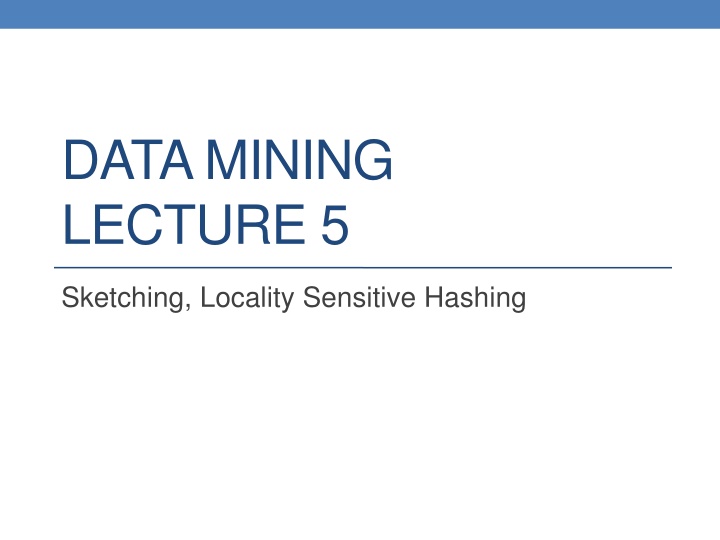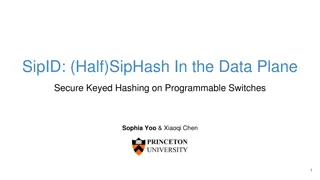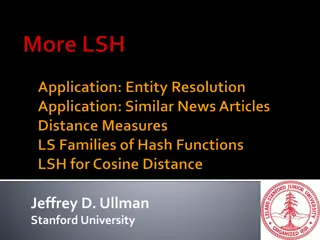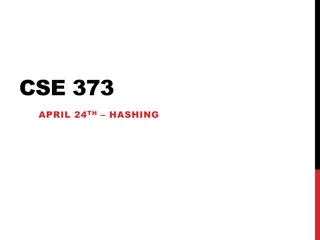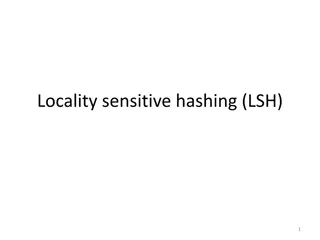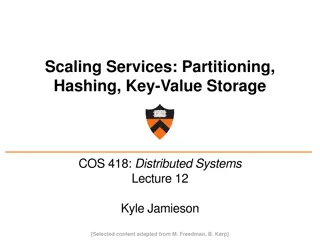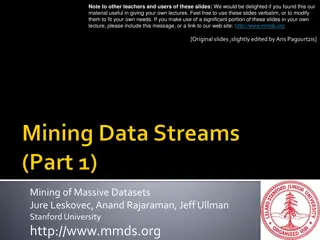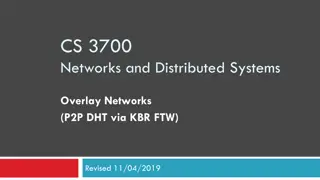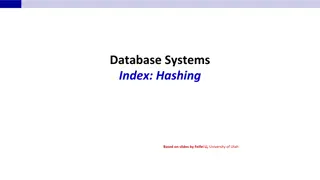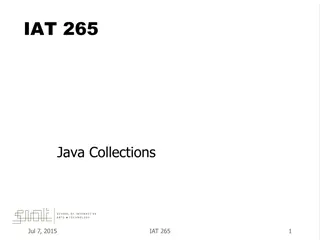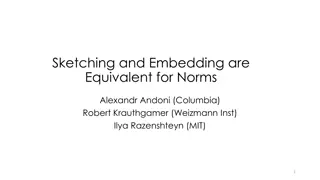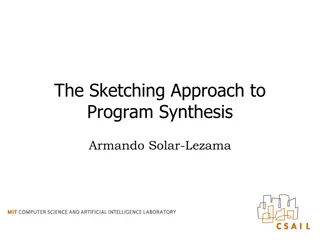Sketching and Locality Sensitive Hashing in Data Mining
Explore the concepts of Jaccard Similarity and Cosine Similarity in data mining, along with their applications in recommendation systems and finding near-duplicates. Discover how Sketching and Locality Sensitive Hashing techniques help in efficiently identifying similar items and solving the Nearest Neighbor problem.
Download Presentation

Please find below an Image/Link to download the presentation.
The content on the website is provided AS IS for your information and personal use only. It may not be sold, licensed, or shared on other websites without obtaining consent from the author.If you encounter any issues during the download, it is possible that the publisher has removed the file from their server.
You are allowed to download the files provided on this website for personal or commercial use, subject to the condition that they are used lawfully. All files are the property of their respective owners.
The content on the website is provided AS IS for your information and personal use only. It may not be sold, licensed, or shared on other websites without obtaining consent from the author.
E N D
Presentation Transcript
DATA MINING LECTURE 5 Sketching, Locality Sensitive Hashing
2 Jaccard Similarity The Jaccard similarity (Jaccard coefficient) of two sets S1, S2 is the size of their intersection divided by the size of their union. JSim(S1, S2) = |S1 S2| / |S1 S2|. 3 in intersection. 8 in union. Jaccard similarity = 3/8 Extreme behavior: Jsim(X,Y) = 1, iff X = Y Jsim(X,Y) = 0 iff X,Y have no elements in common JSim is symmetric
Cosine Similarity Sim(X,Y) = cos(X,Y) The cosine of the angle between X and Y If the vectors are aligned (correlated) angle is zero degrees and cos(X,Y)=1 If the vectors are orthogonal (no common coordinates) angle is 90 degrees and cos(X,Y) = 0 Cosine is commonly used for comparing documents, where we assume that the vectors are normalized by the document length.
Application: Recommendations Recommendation systems When a user buys or rates an item we want to recommend other items that the user may like Initially applied to books, but now recommendations are everywhere: songs, movies, products, restaurants, hotels, etc. Commonly used algorithms: Find the k users most similar to the user at hand and recommend items that they like. Find the items most similar to the items that the user has previously liked, and recommend these items.
Application: Finding near duplicates Find duplicate and near-duplicate documents from a web crawl. Why is it important: Identify mirrored web pages, and avoid indexing them, or serving them multiple times Find replicated news stories and cluster them under a single story. Identify plagiarism Near duplicate documents differ in a few characters, words or sentences
Finding similar items The problems we have seen so far have a common component We need a quick way to find highly similar items to a query item OR, we need a method for finding all pairs of items that are highly similar. Also known as the Nearest Neighbor problem, or the All Nearest Neighbors problem
SKETCHING AND LOCALITY SENSITIVE HASHING Thanks to: Rajaraman and Ullman, Mining Massive Datasets Evimaria Terzi, slides for Data Mining Course.
Before we start: Hash Functions A hash function is a function that maps objects of arbitrary sizes (e.g., strings) to a space of fixed size (usually, integers). Simple example: ? = ?? + ? ??? ? If two values are mapped to the same integer we say that we have a collision Hash functions are usually randomized E.g., values ?,? are selected at random They are designed so that the probability of collision is very small. Perfect hash functions: map each valid input to a different hash value. Hash functions are used in Hash Tables to implement Dictionaries
Problem Given a (large) collection of documents find all pairs of documents which are near duplicates Their similarity is very high What if we want to find identical documents?
Main issues What is the right representation of the document when we check for similarity? E.g., representing a document as a set of characters will not do (why?) When we have billions of documents, keeping the full text in memory is not an option. We need to find a shorter representation How do we do pairwise comparisons of billions of documents? If we wanted exact match it would be ok, can we replicate this idea?
11 Three Essential Techniques for Similar Documents Shingling : convert documents, emails, etc., to sets. 1. Minhashing : convert large sets to short signatures, while preserving similarity. 2. Locality-Sensitive Hashing (LSH): focus on pairs of signatures likely to be similar. 3.
12 The Big Picture Candidate pairs : those pairs of signatures that we need to test for similarity. Locality- sensitive Hashing Docu- ment The set of strings of length k that appear in the doc- ument Signatures: short integer vectors that represent the sets, and reflect their similarity
13 Shingles A k -shingle (or k -gram) for a document is a sequence of kcharacters that appears in the document. Example: document = abcab. k=2 Set of 2-shingles = {ab, bc, ca}. Option: regard shingles as a bag, and count ab twice. Represent a document by its set of k-shingles.
Shingling Shingle: a sequence of k contiguous characters a rose is a rose is a rose a rose is rose is a rose is a ose is a r se is a ro e is a ros is a rose is a rose s a rose i a rose is a rose is
Shingling Shingle: a sequence of k contiguous characters a rose is a rose is a rose a rose is rose is a rose is a ose is a r se is a ro e is a ros is a rose is a rose s a rose i a rose is a rose is a rose is rose is a rose is a ose is a r se is a ro e is a ros is a rose is a rose s a rose i a rose is
16 Working Assumption Documents that have lots of shingles in common have similar text, even if the text appears in different order. Careful: you must pick k large enough, or most documents will have most shingles. Extreme case k = 1: all documents are the same k = 5 is OK for short documents; k = 10 is better for long documents. Alternative ways to define shingles: Use words instead of characters Anchor on stop words (to avoid templates)
17 Shingles: Compression Option To compress long shingles, we can hash them to (say) 4 bytes. :?? 0,164 Represent a doc by the set of hash values of its k- shingles. Shingle ? will be represented by the 64-bit integer (?) From now on we will assume that shingles are integers Collisions are possible, but very rare
Fingerprinting Hash shingles to 64-bit integers Set of Shingles Set of 64-bit integers Hash function (Rabin s fingerprints) 1111 2222 3333 4444 5555 6666 7777 8888 9999 0000 a rose is rose is a rose is a ose is a r se is a ro e is a ros is a rose is a rose s a rose i a rose is
19 Basic Data Model: Sets Document: A document is represented as a set shingles (more accurately, hashes of shingles) Document similarity: Jaccard similarity of the sets of shingles. Common shingles over the union of shingles Sim (C1, C2) = |C1 C2|/|C1 C2|. Although we use the documents as our driving example the techniques we will describe apply to any kind of sets. E.g., similar customers or items.
Signatures Problem: shingle sets are still too large to be kept in memory. Key idea: hash each set S to a small signatureSig (S), such that: Sig (S) is small enough that we can fit a signature in main memory for each set. 1. Sim (S1, S2) is (almost) the same as the similarity of Sig (S1) and Sig (S2). (signature preserves similarity). 2. Warning: This method can produce false negatives, and false positives (if an additional check is not made). False negatives: Similar items deemed as non-similar False positives: Non-similar items deemed as similar
21 From Sets to Boolean Matrices Represent the data as a boolean matrix M Rows = the universe of all possible set elements In our case, shingle fingerprints take values in [0 264-1] Columns = the sets In our case, documents, sets of shingle fingerprints M(r,S) = 1 in row r and column S if and only if r is a member of S. Typical matrix is sparse. We do not really materialize the matrix
Example Universe: U = {A,B,C,D,E,F,G} X = {A,B,F,G} Y = {A,E,F,G} X 1 1 0 0 0 1 1 Y 1 0 0 0 1 1 1 A B C D E F G Sim(X,Y) = 3 5
Example Universe: U = {A,B,C,D,E,F,G} X = {A,B,F,G} Y = {A,E,F,G} X 1 1 0 0 0 1 1 Y 1 0 0 0 1 1 1 A B C D E F G Sim(X,Y) = 3 5 At least one of the columns has value 1
Example Universe: U = {A,B,C,D,E,F,G} X = {A,B,F,G} Y = {A,E,F,G} X 1 1 0 0 0 1 1 Y 1 0 0 0 1 1 1 A B C D E F G Sim(X,Y) = 3 5 Both columns have value 1
25 Minhashing Pick a random permutation of the rows (the universe U). Define hash function for set S h(S) = the index of the first row (in the permuted order) in which column S has 1. same as: h(S) = the index of the first element of S in the permuted order. Use k (e.g., k = 100) independent random permutations to create a signature.
Example of minhash signatures Input matrix Random Permutation elem ent elem ent A B C D E F G index S1 1 1 0 0 0 1 1 S2 0 0 1 1 1 0 0 S3 1 0 0 0 1 1 1 S4 0 1 1 1 1 0 0 S1 S2 S3 S4 1 0 0 1 1 0 1 0 1 0 0 1 0 1 A 1 2 3 4 5 6 7 1 0 1 1 0 1 0 0 1 0 0 1 1 1 A C G F B E D C G F B E D 1 2 1 2
Example of minhash signatures Input matrix Random Permutation index elem ent elem ent A B C D E F G S1 1 1 0 0 0 1 1 S2 0 0 1 1 1 0 0 S3 1 0 0 0 1 1 1 S4 0 1 1 1 1 0 0 S1 0 1 1 0 1 1 0 S2 1 0 0 1 0 0 1 S3 0 0 1 0 1 1 1 S4 1 1 0 1 0 0 1 D 1 2 3 4 5 6 7 D B A C F G E B A C F G E 2 1 3 1
Example of minhash signatures Input matrix Random Permutation index elem ent A B C D E F G elem ent C D G F A B E S1 1 1 0 0 0 1 1 S2 0 0 1 1 1 0 0 S3 1 0 0 0 1 1 1 S4 0 1 1 1 1 0 0 S1 0 0 1 1 1 1 0 S2 1 1 0 0 0 0 1 S3 0 0 1 1 1 0 1 S4 1 1 0 0 0 1 1 C 1 2 3 4 5 6 7 D G F A B E 3 1 3 1
Example of minhash signatures Input matrix Signature matrix S1 1 1 0 0 0 1 1 S2 0 0 1 1 1 0 0 S3 1 0 0 0 1 1 1 S4 0 1 1 1 1 0 0 A B C D E F G We now have a smaller dataset with just ? rows S1 1 2 3 S2 2 1 1 S3 1 3 3 S4 2 1 1 h1 h2 h3 Sig(S) = vector of hash values e.g., Sig(S2) = [2,1,1] Sig(S,i) = value of the i-th hash function for set S E.g., Sig(S2,3) = 1
30 A Subtle Point People sometimes ask whether the minhash value should be the original number of the row, or the number in the permuted order (as we did in our example). Answer: it doesn t matter. You only need to be consistent, and assure that two columns get the same value if and only if their first 1 s in the permuted order are in the same row.
31 Hash function Property Pr(h(S1) = h(S2)) = Sim(S1,S2) where the probability is over all choices of permutations. Why? Recall that the union ?1 ?2 contains the rows with at least one 1. These are the rows that we care about The first row in the permutation where one of the two sets has value 1 belongs to the union. We have equality if both sets have value 1, and this row belongs to the intersection
Example Universe: U = {A,B,C,D,E,F,G} X = {A,B,F,G} Y = {A,E,F,G} Rows C,D could be anywhere they do not affect the probability X Y X Y Union = {A,B,E,F,G} Intersection = {A,F,G} 1 1 0 0 A D D 1 0 B * 0 0 C * 0 0 0 0 D C C 0 1 E * 1 1 F * 1 1 G *
Example Universe: U = {A,B,C,D,E,F,G} X = {A,B,F,G} Y = {A,E,F,G} The * rows belong to the union X Y X Y Union = {A,B,E,F,G} Intersection = {A,F,G} 1 1 0 0 A D D 1 0 B * 0 0 C * 0 0 0 0 D C C 0 1 E * 1 1 F * 1 1 G *
Example Universe: U = {A,B,C,D,E,F,G} X = {A,B,F,G} Y = {A,E,F,G} The question is what is the value of the first * element X Y X Y Union = {A,B,E,F,G} Intersection = {A,F,G} 1 1 0 0 A D D 1 0 B * 0 0 C * 0 0 0 0 D C C 0 1 E * 1 1 F * 1 1 G *
Example Universe: U = {A,B,C,D,E,F,G} X = {A,B,F,G} Y = {A,E,F,G} If it belongs to the intersection then h(X) = h(Y) X Y X Y Union = {A,B,E,F,G} Intersection = {A,F,G} 1 1 0 0 A D D 1 0 B * 0 0 C * 0 0 0 0 D C C 0 1 E * 1 1 F * 1 1 G *
Example Universe: U = {A,B,C,D,E,F,G} X = {A,B,F,G} Y = {A,E,F,G} Every element of the union is equally likely to be the * element Pr(h(X) = h(Y)) = | A,F,G | | A,B,E,F,G |=3 5= Sim(X,Y) X Y X Y Union = {A,B,E,F,G} Intersection = {A,F,G} 1 1 0 0 A D D 1 0 B * 0 0 C * 0 0 0 0 D C C 0 1 E * 1 1 F * 1 1 G *
37 Similarity for Signatures The similarity of signatures is the fraction of the hash functions in which they agree. S1 1 S2 0 S3 1 S4 0 Signature matrix Actual Sig A (S1, S2) (S1, S3) (S1, S4) (S2, S3) (S2, S4) (S3, S4) 0 0 S1 1 S2 2 S3 1 S4 2 B 1 0 0 1 3/5 2/3 C 0 1 0 1 1/7 0 2 1 3 1 D 0 1 0 1 0 0 3 1 3 1 E 0 1 1 1 3/4 1 F 1 0 1 0 0 0 Zero similarity is preserved High similarity is well approximated G 1 0 1 0 With multiple signatures we get a good approximation Why? What is the expected value of the fraction of agreements?
Is it now feasible? Assume a billion rows Hard to pick a random permutation of 1 billion Even representing a random permutation requires 1 billion entries!!! How about accessing rows in permuted order? Instead of permutations we will consider hash functions that map the N rows to N buckets Some collisions may happen, but with well chosen functions they are rare.
Approximating row permutations Pick k=100 hash functions (h1, ,hk) for each set S for each row r that appears in S for each hash function hi compute hi (r ) for each hash function hi Sig(S,i) = min hi (r); In practice this means selecting the function parameters hi (r) = index of shingle r in permutation Find the minimum index for hash function hi Sig(S,i) will become the smallest value of hi(r) among all rows (shingles) for which column S has value 1 (shingle belongs in S); i.e., hi (r) gives the min index for thei-th permutation
Approximating row permutations In practice this means selecting the function parameters Pick k=100 hash functions (h1, ,hk) for each row r for each hash function hi compute hi (r ) for each column Sthathas 1 in row r ifhi (r ) is a smaller value than Sig(S,i)then Sig(S,i) = hi (r); In practice only the rows (shingles) that appear in the data hi (r) = index of shingle r in permutation S contains shingle r Find the shingle r with minimum index Sig(S,i) will become the smallest value of hi(r) among all rows (shingles) for which column S has value 1 (shingle belongs in S); i.e., hi (r) gives the min index for thei-th permutation
41 Example Sig1 Sig2 h(0) = 1 g(0) = 3 1 3 - - Row S1 A B C D E S2 0 1 1 0 1 x 0 1 2 3 4 h(x) 1 2 3 4 0 g(x) 3 0 2 4 1 1 0 1 1 0 h(1) = 2 g(1) = 0 1 3 2 0 h(2) = 3 g(2) = 2 1 2 2 0 h(3) = 4 g(3) = 4 1 2 2 0 h(x) = x+1 mod 5 g(x) = 2x+1 mod 5 h(4) = 0 g(4) = 1 1 2 0 0 Row S1 S2 B 0 1 E 0 1 C 1 0 A 1 D 1 Row S1 S2 E 0 1 A 1 B 0 1 C 1 1 D 1 0 0 1 0
42 Implementation (4) Often, data is given by column, not row. E.g., columns = documents, rows = shingles. If so, sort matrix once so it is by row. And always compute hi (r ) only once for each row.
43 Finding similar pairs Problem: Find all pairs of documents with similarity at least t = 0.8 While the signatures of all columns may fit in main memory, comparing the signatures of all pairs of columns is quadratic in the number of columns. Example: 106 columns implies 5*1011 column- comparisons. At 1 microsecond/comparison: 6 days.
44 Locality-Sensitive Hashing What we want: a function f(X,Y) that tells whether or not X and Y is a candidate pair: a pair of elements whose similarity must be evaluated. A simple idea: X and Y are a candidate pair if they have the same min-hash signature. Easy to test by hashing the signatures. Similar sets are more likely to have the same signature. Likely to produce many false negatives. Requiring full match of signature is strict, some similar sets will be lost. ! Multiple levels of Hashing! Improvement: Compute multiple signatures; candidate pairs should have at least one common signature. Reduce the probability for false negatives.
45 Signature matrix reminder Prob(Sig(S,i) == Sig(S ,i)) = sim(S,S ) Sig(S,i) Sig(S ,i) hash function i n hash functions Sig(S): signature for set S signature for set S Matrix M
46 Partition into Bands (1) Divide the signature matrix Sig into b bands of r rows. Each band is a mini-signature with r hash functions.
47 Partitioning into bands Matrix Sig n = b*r hash functions r rows per band b bands b mini-signatures One signature
48 Partition into Bands (2) Divide the signature matrix Sig into b bands of r rows. Each band is a mini-signature with r hash functions. For each band, hash the mini-signature to a hash table. Mini-signatures that hash to the same bucket are almost certainly identical.
49 Columns 2 and 6 are (almost certainly) identical. Hash Table Columns 6 and 7 are surely different. Matrix M 1 2 3 4 5 6 7 b bands r rows
50 Partition into Bands (2) Divide the signature matrix Sig into b bands of r rows. Each band is a mini-signature with r hash functions. For each band, hash the mini-signature to a hash table. Mini-signatures that hash to the same bucket are almost certainly identical. Candidate column pairs are those that hash to the same bucket for at least 1 band. I.e., they have at least one mini-signature in common. Tune b and r to catch most similar pairs, but few non- similar pairs.
